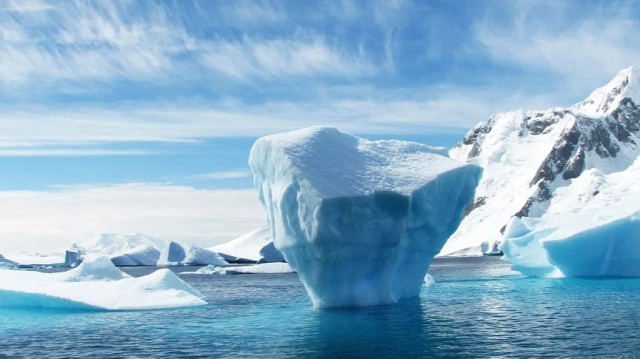
‘Most previous megabergs have broken up roughly near South Georgia, which is probably only a month or so away from the berg's current position,' researcher tells Anadolu
Scientists predict that the world's largest iceberg, A23a, will break apart within a month after escaping a whirlpool it was trapped in January 2024 and being carried toward Antarctica.
A23a broke off from the Filchner-Ronne Ice Shelf in Antarctica in August 1986.
The iceberg remained stationary for approximately 34 years.
But in 2020, ocean currents began moving it and it started drifting toward the western part of the Weddell Sea.
During its journey, the iceberg became trapped in a whirlpool and spun around it from January until mid-December in 2024.
Now freed from the whirlpool, A23a is being pulled toward Antarctica.
Andrew Meijers, deputy science leader of the Polar Oceans Team at the British Antarctic Survey (BAS), explained the details of A23a's new journey to Anadolu.
Meijers said they did not observe any external factors influencing the iceberg's escape from the whirlpool, but he speculated that strong currents and winds in the region may have played a role.
He noted that the iceberg is now clearly within the Antarctic Circumpolar Current and will continue to move northeast toward South Georgia.
Meijers said the complete melting of the iceberg depends on its location, pointing out that the Antarctic Circumpolar Current is known for its strong currents, which affect ocean temperatures.
As the iceberg moves northward, the temperature is expected to rise, accelerating the melting process.
“This will significantly accelerate its rate of melt, as will the generally warming up surface ocean temperatures as the Southern Hemisphere moves into summer. Most previous megabergs have broken up roughly near South Georgia, which is probably only a month or so away from the berg's current position.
“However, it isn't unknown for bergs to make it much further north, and if it manages to ride a fast ocean jet, it could potentially make it closer to South Africa,” he added.
Meijers also pointed out that A23a could make various contributions to the ecosystem in the region.
Due to its significant size, the iceberg brings nutrient-rich waters from the deep ocean to the surface, including iron, zinc and other micro-nutrients.
This process can stimulate the growth of phytoplankton, which in turn benefits krill and predators that rely on this food source.
“On the negative side, if the iceberg grounds near to South Georgia, it has the potential to make life harder for penguin and seal colonies there. If it blocks access to feeding grounds, these animals must swim a lot further to get food, which puts them under stress,” he added.
Meijers also said that previous icebergs reaching the region have caused the death of many marine creatures, including a significant number of juveniles.
He added that the increasing number of broken iceberg fragments in the area could further restrict movement, making commercial fishing activities more difficult.
Meijers said the process of iceberg formation is entirely natural.
However, he noted a significant increase in the frequency of iceberg calving events in Antarctica in recent years.
“This is primarily driven by increased melting of ice shelves from below by the ocean, due to increased ocean temperatures. The exact driver of the ocean temperature increase is still actively being researched, but a prime candidate is human-induced climate change.
“We have also seen a procession of ice shelves collapse down the eastern side of the Antarctic peninsula, notably the Larson A and B ice shelves, and these ice shelve collapses have also been attributed to human-driven climate change,” he added.

